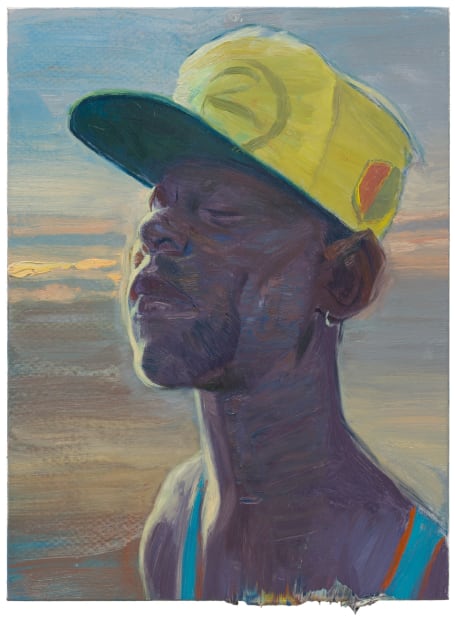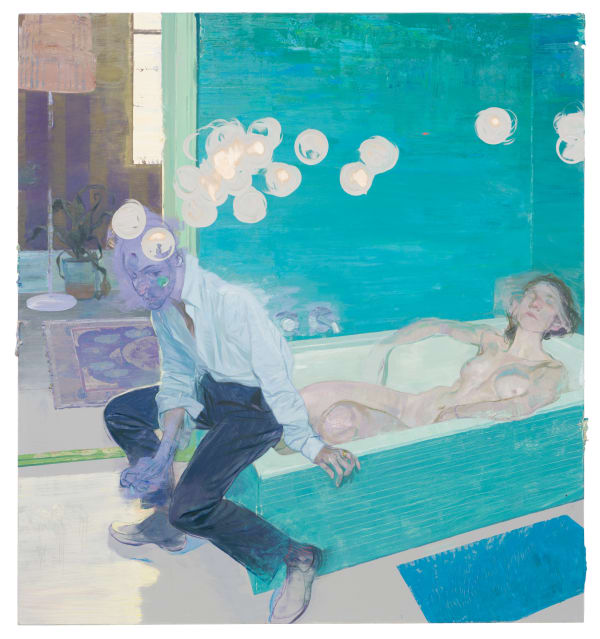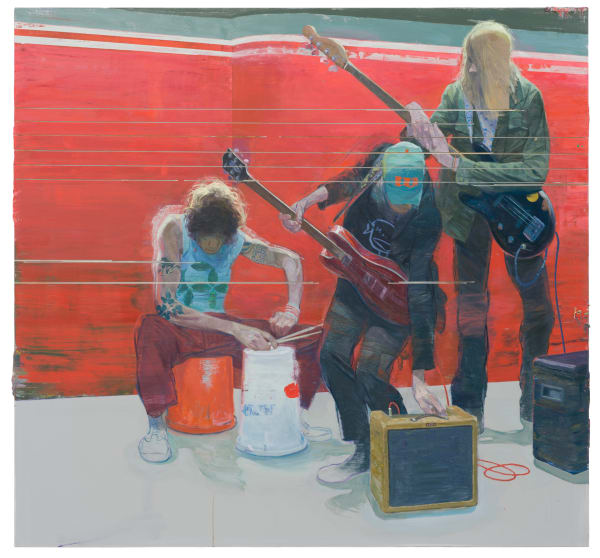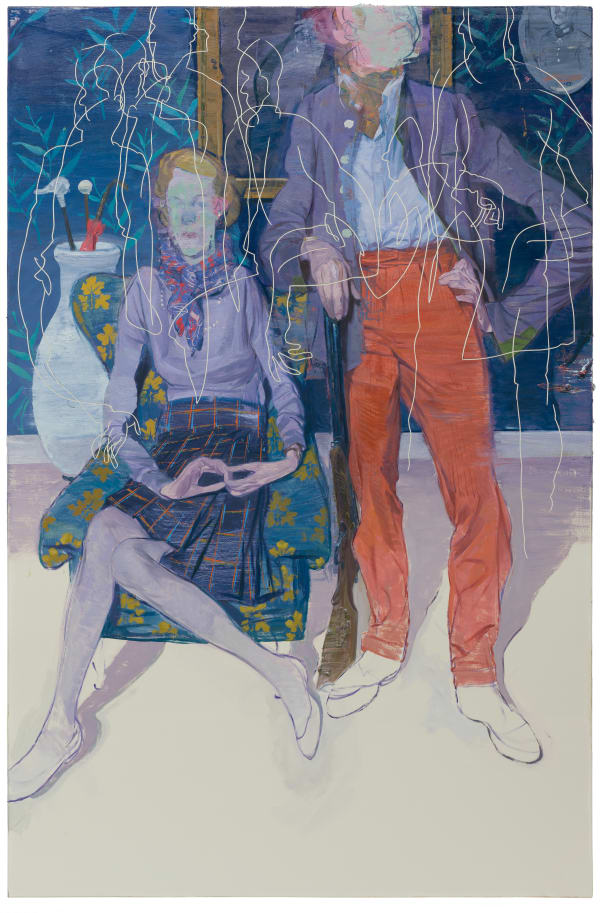-
Ruprecht von Kaufmann
In the Street -

-
-
Solo exhibitions include In The Street, (Upcoming), Kristin Hjellegjerde Gallery, London (2022); Leben zwischen den Stühlen, (Upcoming), Buchheim Museum, Bernried (2022); Inside The Outside, City Gallery Gutshaus Steglitz, Berlin (2021); Inside The Outside, Museen Böttcherstrasse, Bremen and UN Headquaters, New York (2021); The Three Princes of Serendip, Kristin Hjellegjerde Gallery, London (2020); Augen fest geschlossen, Galerie Thomas Fuchs, Stuttgart, (2019); Die drei Prinzen von Serendip, Kunstsammlung Neubranderburg, Neubranderburg (2019); Die Evakuierung des Himmels, Kunsthalle Erfurt, Erfurt (2018); Ruprecht von Kaufmann, Galerie Thomas Fuchs, Stuttgart (2018); Liederbuch, Galerie Thomas Fuchs, Stuttgart (2018), Event Horizon, Kristin Hjellegjerde Gallery, London (2017); Fabel, Georg Kolbe Museum, Berlin (2014); Carna(va)l, Museum Abtei Liesborn, (2014).
Group exhibitions include On The Wall, curated by Demetrio Paparoni, Building Gallery, Milan (2022); Fernweh, Galerie Thomas Fuchs, Stuttgart (2021); All the Days and Nights, Kristin Hjellegjerde Gallery, London (2020); Feelings, Pinakothek der Moderne, Munich (2019); Metaphysica, Haugar Art Museum, Tønsberg, Norway (2019); Birkholm’s Echo, Faaborg Museum of Art, Faaborg, Denmark (2019); Contemporary Chaos, Vesfossen Kunslaboratoreum, Vestfossen, Norway (2018); Metaphysica, Haugar Art Museum Tønsberg, Norway (2018); Schwarze Romantik, Künstlerhaus Thurn & Taxis, Bregenz, Topicuv Salon, Prague (2018) and Ecce Creatura, Kallmann Museum, Ismaning (2017); Wahlverwandschaften, German Art since the 1960s, Latvian National Museum, Riga, Latvia, The Sea, Brandts Museum, Odense, Denmark (2014), I am a Berliner, Tel Aviv Art Museum , Israel (2011).
-
Highlights and collections
Ruprecht Von Kaufmann’s work can be found in international private and public collections, including the Collection of the Federal Republic of Germany; Collection of the German Bundestag; Collection of the National Bank of the Federal Republic of Germany, Frankfurt; Coleccion Solo, Madrid; Collection Ole Faarup, Copenhagen, DK; AmC Collezione Coppola, Vicenza; Hort Family Collection, New York; Uzyiel Collection, London; Philara Collection, Düsseldorf ; Hildebrand Collection, Leipzig; Collection Holger Friedrich, Berlin; Collection Museum Abtei Liesborn, Liesborn; Collection Veronika Smetackova, Prague.
-
-

-
-
In his work, Dix captured a time of global upheaval and change: Europe had evolved from primarily rural and aristocratic society into an industrialist society and was creaking under the strain of the competing forces of budding democracy, conservatism and totalitarianism. Now, a hundred years on, von Kaufmann is painting our world with the same astute detail, but with a greater fluidity and dynamism that seems to capture the ephemerality, speed and instability of modern existence. His figures often appear in flux, blurred, incomplete and disjointed. As he says: “We can all feel that we are on the brink of very fundamental changes, from a carbon based-economy of manic growth to, well, we don’t quite know yet, do we?”
Yet, in his paintings von Kaufmann also draws our attention to the eerie similarities between our present-day and Dix’s vision of the 1920s. There are still the aristocrats stuck in their old-fashioned ways of thinking, people living on the street, party goers, musicians busking to disinterested audiences and the rich who see making money as a sport, as the purpose of living. The painting Here comes Success, for example, depicts a couple leaning against a red sports car. The man’s pose in particular suggests a strong sense of pride and self-entitlement: his hand is thrust into his pocket, showing off the glinting gold of his watch while his wife (or girlfriend?) looks up at him adoringly, holding the lead of their dog. It’s a familiar, almost stereotypical scene of privilege and yet, it is also chaotic, loud, incomplete. The background is abstract with tumultuous and at times, aggressive marks of red paint. Portions of the linoleum surface have been cut out or scraped away - there are two perfectly formed holes, one drilled through the body of the car and another through the woman’s stomach, seemingly indicating the emptiness of her posture - and lines, like sound waves, run from one side of the image to the other, the clamour of the city breaking through their seamless version of reality.
-
However, unlike Dix’s often brutal depictions of society, there’s a strong sense of empathy in von Kaufman's representations that capture interior states as well as moments of time. His figures appear as “types” only to emerge as complex, layered beings. With the couple by the sports car, for example, the chaotic, loose gestures and deep embedded marks invite the viewer to see beyond the superficial and to feel the anxiety and stress of contemporary life. “My hope is that when looking at the paintings viewers will be repulsed and attracted in equal measure by who they see, because they recognise something of themselves, maybe a part of themselves, they would rather not be made aware of,” says the artist.
The contrast between the smooth, dense surface of the linoleum over which von Kaufman’s brushstrokes glide and the more violent moments of mark-making where the artist carves into the surface using a disc sander and circular saw creates a kind of off-beat rhythm that permeates the exhibition, as if conveying the stuttering, unexpected syncopations of everyday life. This is perhaps most strongly felt in the painting of a street-band busking in the subway through which the artist has cut lines with a power saw, like the screeches on an incoming train but also like empty lines of sheet music. The performance is simultaneously disrupted by the lines and memorialised. In this way, von Kauffman finds equal meaning and weight to each gesture and individual. He invites us to view with generosity rather than judgement.
As the exhibition’s title suggests, the paintings attempt to bring us closer, not further away, to life as it is lived, in the street, from inside our heads and in doing so, the works create a sense of togetherness because in essence, we are all part of the same fast-changing, surreal picture, stumbling towards an unknown future that leaves us bewildered, caught up in our own lives, as we try to live and find our own small moments of happiness.
-
-
Enquire
-
 Ruprecht von Kaufmann, Die Tochter, 2021
Ruprecht von Kaufmann, Die Tochter, 2021 -
 Ruprecht von Kaufmann, Fame, 2021
Ruprecht von Kaufmann, Fame, 2021 -
 Ruprecht von Kaufmann, Fake Plastic Trees, 2021
Ruprecht von Kaufmann, Fake Plastic Trees, 2021 -
 Ruprecht von Kaufmann, Die Mutter, 2021
Ruprecht von Kaufmann, Die Mutter, 2021
-
 Ruprecht Von Kaufmann, Can´t Stand that Feeling, 2022
Ruprecht Von Kaufmann, Can´t Stand that Feeling, 2022 -
 Ruprecht von Kaufmann, Borsolino, 2021
Ruprecht von Kaufmann, Borsolino, 2021 -
 Ruprecht von Kaufmann, Couple, 2021
Ruprecht von Kaufmann, Couple, 2021 -
 Ruprecht Von Kaufmann, ... After We Die, 2022
Ruprecht Von Kaufmann, ... After We Die, 2022
-
 Ruprecht von Kaufmann, Die Band, 2021
Ruprecht von Kaufmann, Die Band, 2021 -
 Ruprecht von Kaufmann, Here comes Success, 2021
Ruprecht von Kaufmann, Here comes Success, 2021 -
 Ruprecht von Kaufmann, I Rise, 2021
Ruprecht von Kaufmann, I Rise, 2021 -
 Ruprecht Von Kaufmann, In the Face of It, 2019
Ruprecht Von Kaufmann, In the Face of It, 2019
-
-
Ruprecht von Kaufmann: In the Street
Past viewing_room





















